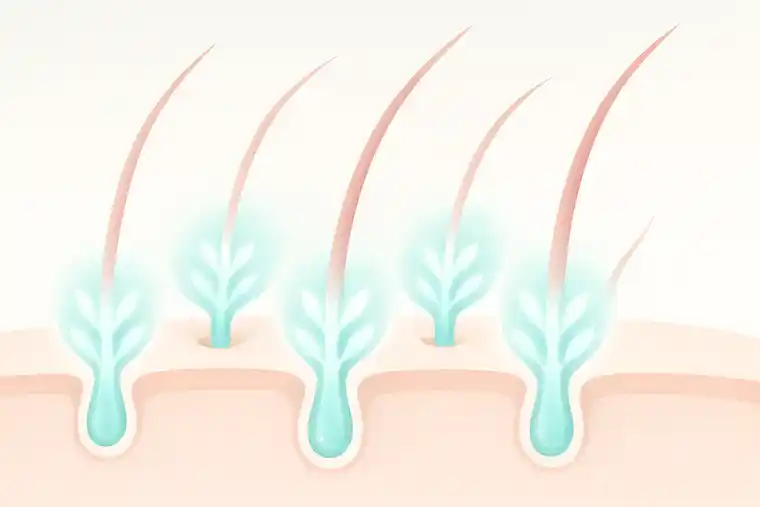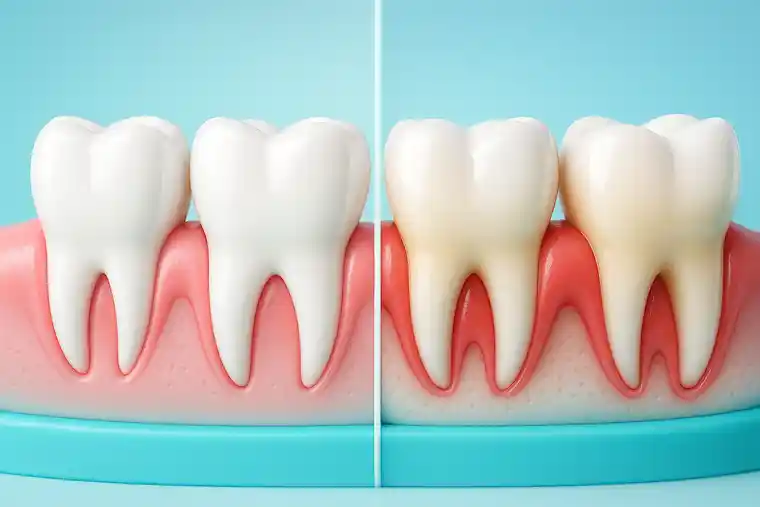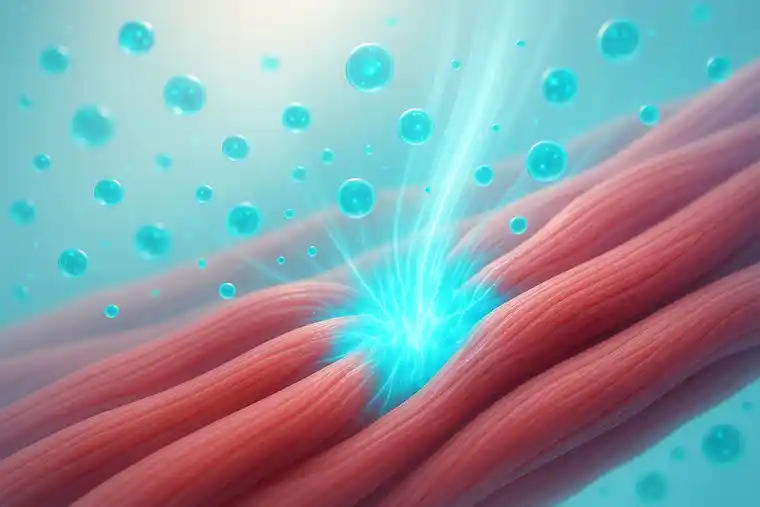Unlocking Exosomes – Structure, Contents, and Why Every Molecule Matters – Insights by Prof. Dr. Erdinç Civelek, MD, PhD (C)
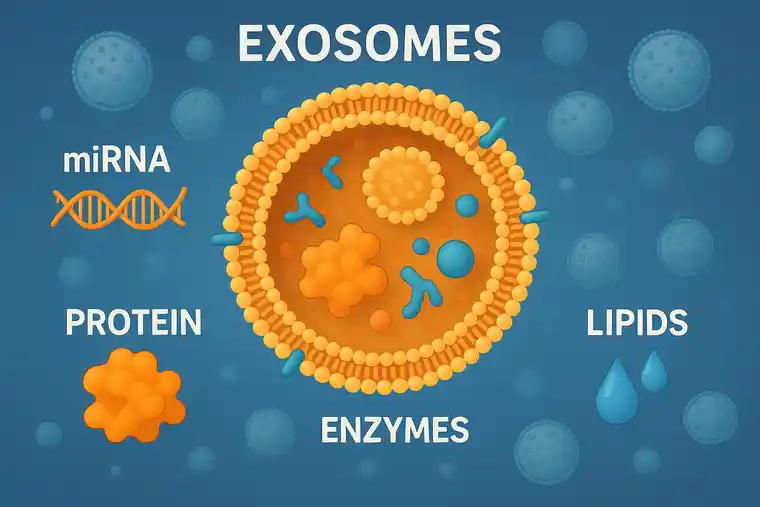
Written by Prof. Dr. Erdinç Civelek, MD, PhD (C)
Exosome: When Healing Becomes Communication
There’s a quiet revolution underway in medicine—not marked by loud headlines or overnight miracles, but by something far more elegant: communication. Not between doctors and patients, but between the very cells that make up our bodies.
For decades, we believed healing was mostly about replacing or repairing tissue—through surgery, medication, or cellular transplants. But what if much of the body’s regenerative capacity depended not on what you add—but on what you say?
That’s where exosomes come in.
In clinical practice, I’ve seen patients with chronic joint pain, neurological injuries, and inflammatory and autoimmune conditions all respond not to invasive procedures, but to tiny, whispering biological messengers. These microscopic vesicles—called exosomes—carry more than molecules. They carry instructions. They travel from one cell to another, delivering information that tells tissues how to reduce inflammation, how to repair, how to begin again.
If stem cells are the architects of repair, then exosomes are the blueprints. They tell the body what to build, how to coordinate, when to start—and, perhaps more importantly, when to stop.
And the most remarkable part? We’re only beginning to understand what they’re capable of.
Table of Contents
What Are Exosomes and how do they work?
Let’s strip away the jargon.
Exosomes are nano-sized bubbles, about 1/1000th the width of a human hair. They are released naturally by most cells in the body, especially those involved in growth, repair, or immune response. Think of them as little couriers—biological parcels wrapped in a protective membrane—carrying a precious and highly specific cargo of proteins, genetic instructions (in the form of mRNA and microRNA), enzymes, and sometimes even hormones.
Every exosome reflects the identity and health of the cell it comes from. If a stem cell is young and vibrant, its exosomes will be loaded with growth-promoting and anti-inflammatory messages. If a cell is damaged or aged, its exosomes might convey the opposite.
These nanoscale, critical intercelular messengers carry biomolecular signatures reflecting their parent cells, making them powerful tools for non-invasive diagnostics and therapeutic monitoring. In future, we will talk about exosome-based drug delivery.
This is why source matters. It’s also why exosome therapy, when done correctly, holds such promise: we’re not trying to force the body into healing – we’re giving it the right messages so it can heal itself.
How Exosomes Work: Beyond the Microscope
In a laboratory, you can observe exosomes binding to recipient cells and merging with their membranes. Under a microscope, it’s all very technical – vesicle fusion, receptor binding, RNA translation.
But in the body, what’s happening is far more poetic.
Exosomes don’t simply deposit chemicals. They instruct. A neuron damaged by stroke might receive an exosome that helps it resist apoptosis. An immune cell spiraling into autoimmunity might be told to stand down. A skin cell caught in chronic inflammation might get the message to rebuild, not react.
This kind of signaling is orchestrated, not random. And unlike pharmaceutical drugs that affect multiple systems at once – sometimes to harmful effect – exosomes are often targeted. They carry molecular “zip codes” that help them home in on specific tissues.
They aren’t just small. They’re smart.
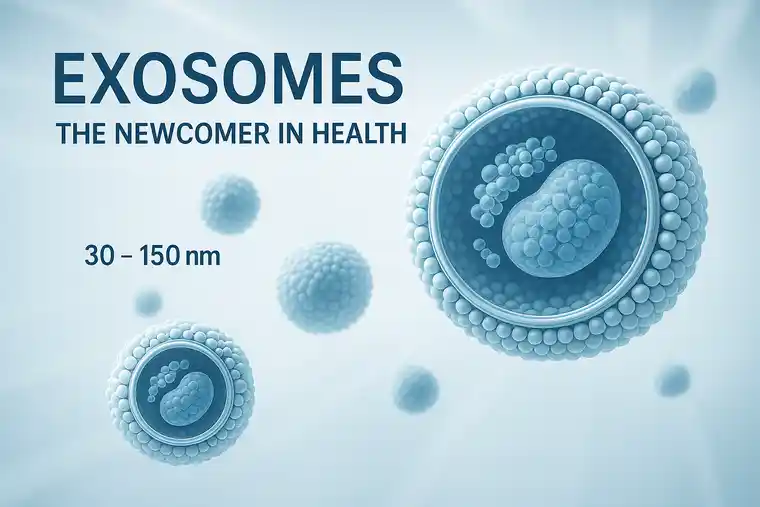
Inside the Exosome: Nature’s Nanotech
MicroRNA (miRNA)
These are short, non-coding RNA strands that act as master regulators. They don’t build proteins—they control which proteins get built. For this reason, exosomes do not alter the patient’s genetic code or cause genetic transfer. They only contribute to regeneration by accelerating the synthesis of important proteins.
Some microRNAs found in therapeutic exosomes include:
- miR-124 – Supports neurogenesis, calms neural inflammation
- miR-21 – Suppresses fibrosis, a key factor in chronic inflammation
- miR-146a – Helps calm autoimmune overactivity
- miR-155 – Pro-inflammatory; often filtered out in clinical-grade exosomes
In autoimmune patients, balancing these miRNAs can mean the difference between chronic fatigue and meaningful relief.
Proteins & Enzymes
Exosomes often carry:
- Cytokines (to calm inflammation)
- Enzymes (to break down scar tissue or remodel damaged areas)
- Heat-shock proteins (to reduce oxidative stress)
- Tetraspanins (markers that help identify and sort exosomes)
Each protein plays a role in shaping the response. This is not chemical guesswork. It’s molecular choreography.
Lipids
They aren’t just passive membranes. Exosomal lipids like sphingomyelin, phosphatidylserine, and ceramides influence cell signaling, membrane fluidity, and even immune targeting. In dermatology, for example, these lipids help exosomes merge with keratinocytes and fibroblasts to enhance skin repair.
Why Exosome Source Matters More Than You Think
In the clinical world, I often tell patients: “The power of exosomes depends on where they come from.”
Umbilical Cord-Derived MSC Exosomes
These are my preferred choice for most regenerative applications. Why? They’re:
- Youthful (no age-related inflammation signals)
- Immunologically neutral (low chance of rejection)
- Rich in growth factors, miRNAs, and anti-fibrotic molecules
- Ethically sourced from full-term, healthy births
Placental Exosomes
Similar to umbilical cord in potency, with strong immunomodulatory potential. These are often used in patients with systemic inflammation or autoimmune conditions.
Adipose or Bone Marrow Sources
While still used in some clinics, the donor’s age can dramatically affect exosomal quality. In older patients, the message may be less about regeneration—and more about maintenance or inflammation.
Tumor Cell Exosomes
Used exclusively in research. Therapeutically dangerous. They often carry oncogenic (cancer-promoting) signals.
From Cell to Vial: The Exosome Manufacturing Journey
Creating exosomes that are safe, potent, and consistent isn’t something that happens in a backroom centrifuge. It requires:
- Sterile, controlled culture environments
- Precise stimulation of donor cells to optimize yield
- Filtration and ultracentrifugation to isolate vesicles
- Rigorous purification to remove non-exosomal particles
- Cryopreservation to preserve structure and bioactivity
The laboratory we work with goes even further, implementing GMP-certified protocols that include:
- HLA typing
- Endotoxin testing
- Mycoplasma detection
- Flow cytometry for CD63, CD9, and CD81
- Tumorigenicity screening (to eliminate oncogenic risk)
- Documented chain-of-custody from donor to patient
Why does this matter?
Because exosomes are subtle. A minor impurity can affect the therapeutic response – or worse, introduce a risk. That’s why we don’t cut corners. In this field, precision is medicine.
Real-World Applications: Where Exosomes Are Already Changing Lives
Despite their microscopic size, exosomes are making a macro-level impact. Across multiple fields of medicine, they are quietly improving outcomes, reducing inflammation, accelerating recovery, and—most strikingly—helping patients who were previously out of options.
Let’s walk through where and how exosomes are now being used.
Neurology and Neurosurgery: Exosomes as Hope for the Brain and Spinal Cord
Few areas of medicine are more emotionally charged than brain and spinal cord injury and neurodegeneration. When we work with patients suffering from traumatic brain injury, spinal cord injury, hypoxic ischemic encephalopathy (HIE), stroke, Multiple sclerosis, cerebral palsy, Parkinson’s disease, or even conditions like autism spectrum disorder (ASD), one thing becomes clear: conventional treatments often focus on managing symptoms, not repairing the cause.
Exosomes may change that. Why?
Because they cross the blood-brain barrier—a feat that most drugs cannot accomplish.
Once inside the central nervous system, they:
- Reduce neuroinflammation
- Deliver miRNAs that protect neurons
- Activate resident stem cells
- Encourage axonal growth and synaptic remodeling
Exosomes as Hope for Peripheral Nerve Injury and Lumbar Degenerative Intervertebral Disc Disease
Exosomes can
- modulate inflammation
- promote axonal growth
- enhance Schwann cell proliferation and migration which are main mechanisms in nerve regeneration.
The neuroprotective effects are largely attributed to the transfer of many growth factors and regulatory RNAs (such as miR-21 and miR-124), which can suppress apoptosis and stimulate repair pathways.
Local, İntrathecal or transcaudal administration of exosomes has led to improved nerve conduction velocity, reduced inflammatory responses, and enhanced functional recovery.
Their low immunogenicity and ability to cross biological barriers make them particularly attractive for clinical translation.
Degenerative intervertebral disc disease (lumbar disc herniation) is characterized by progressive breakdown of intervertebral discs, leading to chronic back pain, spinal instability, and neurological symptoms.
Disc degeneration involves the loss of extracellular matrix (ECM) components, inflammation, and cell death within the nucleus pulposus and annulus fibrosus.
Exosomes have shown potential to modulate disc degeneration at multiple levels.
Exosomes can
- stimulate Extracelluler matrix (ECM) synthesis (e.g., collagen II and aggrecan)
- inhibit matrix-degrading enzymes (e.g., MMPs)
- suppress inflammatory cytokines such as IL-1β and TNF-α
- reduce oxidative stress
- prevent apoptosis in disc cells, preserving disc structure and function
Therefore, they control low-back pain and radicular leg pain. Intradiscal injection of exosomes can mitigate disc height loss, maintain hydration, and improve biomechanical properties.
Exosomes and Autism Spectrum Disorder (ASD)
While autism is not a degenerative condition, mounting evidence points to neuroinflammation and immune dysregulation as contributing factors. Exosomes -thanks to their ability to cross the blood-brain barrier and modulate both neural and immune pathways – are now being explored as a supportive therapy for children with ASD.
In practice, we’ve observed encouraging early responses: improved emotional regulation, better sleep patterns, and – most meaningfully for families – small but impactful changes in eye contact, communication, and social engagement. While these outcomes vary and are not a cure, they offer a new path worth investigating.
Clinical research into exosome therapy for ASD is still ongoing, and any use should be carefully reviewed with medical professionals experienced in neurological and pediatric care.
Over the years, I’ve worked with stroke patients whose recoveries defied initial prognoses – not because of aggressive intervention, but because we gave the brain the right environment to reorganize itself. In cases where exosomes were introduced during the early stages of neurorehabilitation, we began noticing gains in motor coordination and mental clarity that felt encouraging, if not remarkable.
With degenerative conditions like Parkinson’s or Alzheimer’s, the story is slower, and often gentler. Improvements may take the form of steadier gait, fewer episodes of confusion, or simply a better sense of self. Families notice these shifts first – less agitation, improved mood regulation, or a glimmer of old personality resurfacing.
And in some children on the autism spectrum, after exosomal support, parents have quietly shared milestones that may seem small on paper—like deeper eye contact or longer stretches of uninterrupted sleep—but feel monumental in their homes. Of course, responses vary, and we always proceed with both optimism and scientific caution.
Orthopedics: Exosomes Beyond Joint Injections
When patients walk into my office with joint degeneration, rotator cuff tears, or chronic tendonitis, they often expect one of two recommendations: cortisone or surgery.
But exosomes offer a third path.
Derived from mesenchymal sources, they stimulate:
- Collagen production
- Fibroblast activation
- Angiogenesis (new blood vessel growth)
- Modulation of the M1/M2 macrophage balance (inflammation resolution)
In joints, this means less swelling, more lubrication, and actual remodeling of damaged cartilage. In tendons, it means improved elasticity and faster recovery.
What patients notice first is the reduction in pain. What keeps them returning is the return of function—without the downtime of surgery or the side effects of steroids.
Autoimmune Diseases: Calming the Fire Within With Exosomes
Autoimmune patients often live in cycles—flare, fatigue, medication, repeat. Their immune system, designed to protect, has turned inward.
Exosomes don’t suppress the immune system like immunosuppressive drugs do. Instead, they modulate it. They help the body remember balance.
Key mechanisms include:
- Downregulating pro-inflammatory cytokines
- Promoting regulatory T-cell function
- Inhibiting overactive antigen presentation
- Suppressing autoreactive B-cell and T-cell pathways
In patients with rheumatoid arthritis, lupus, or multiple sclerosis, we often observe:
- Reduced joint swelling and morning stiffness
- More predictable energy levels
- Decreased need for steroids or DMARDs over time (under medical supervision)
We’re not talking about miracles. We’re talking about a deeper intelligence within the immune system being gently reminded of how to function properly.
Aesthetic Dermatology: Regeneration Meets Rejuvenation with Exosomes
The skin often tells the first story of aging—and sometimes the harshest one. But what we see on the surface reflects deeper biological processes: inflammation simmering under the dermis, oxidative stress breaking down collagen, and cellular sluggishness in regeneration.
In aesthetic medicine, exosomes are becoming an invaluable ally—not for masking time, but for rewinding some of its more visible effects. When paired with procedures like microneedling or fractional lasers, they don’t just speed up healing—they seem to refine it.
What we’ve observed includes richer skin texture, subtle tightening, and a kind of glow that doesn’t come from hydration alone. The post-treatment redness fades faster. Fine lines appear softer. In patients struggling with hair thinning, especially due to hormonal shifts, exosomal therapy has helped stimulate dormant follicles into new growth cycles.
What stands out is not the dramatic—but the durable. The kind of improvement that doesn’t scream “cosmetic” but quietly says, “healthier.”
Exosomes don’t just mask signs of aging. They encourage the biology of youth to reawaken.
Exosomes in Oncology: The Cautious Frontier
While we never use exosomes therapeutically in cancer without full ethical and scientific clarity, the research is compelling.
Tumor-derived exosomes can carry biomarkers useful for early detection or understanding metastasis. Therapeutically, engineered exosomes are being explored as:
- Drug delivery systems (to transport chemotherapy directly to tumors)
- Immune stimulants (as personalized cancer vaccines)
This is still an experimental field. But in the right hands and settings, exosomes may one day offer targeted, less toxic alternatives to current therapies.
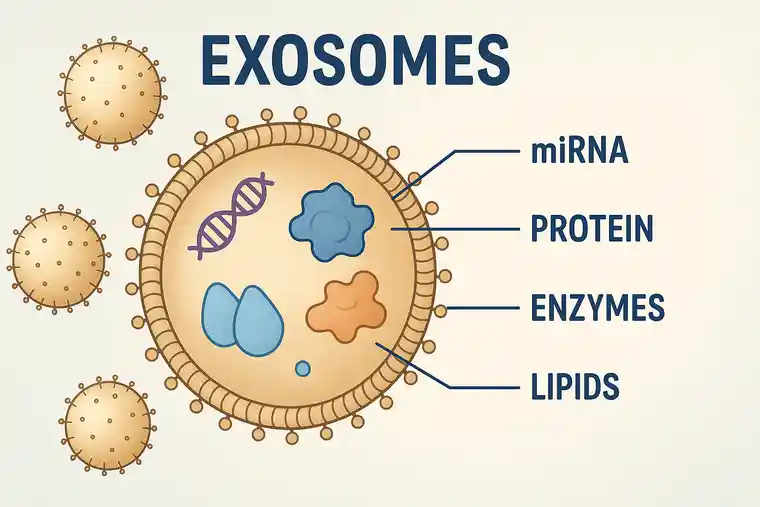
Are Exosomes Safe?
Exosome therapy is considered generally safe in early studies.
This is the question I hear most often – and rightly so. When a patient entrusts us with their health, they deserve transparency.
Here’s what we know from both research and real-world clinical practice:
What Makes Exosomes Safer Than Stem Cells and How do exosomes compare to stem cells in regenerative medicine?
| Comparison Factor | Exosomes | Mesenchymal Stem Cells |
|---|---|---|
| Live Cells Present? | ❌ No | ✅ Yes |
| Risk of Tumor Formation | ❌ No | Very, very low (no case in litarutary). Embrionic stem cells have tumor formation capacity |
| Risk of Immune Rejection | Very, very low | Moderate |
| Standardization & Storage | Easily standardized & cryopreserved | Complex logistics |
| Regulatory Simplicity | More flexible in many jurisdictions | Highly regulated |
🧪 Safety Depends on Process, Not Just Product
This is where our laboratory plays a critical role.
Every sample is screened, processed, and tracked according to international GMP guidelines. We never begin with assumptions—we begin with testing.
Donor Evaluation & Screening
Before any biological material is accepted, the donor undergoes a multi-step evaluation:
- Medical and Genetic History Review: Potential donors undergo thorough evaluations to identify any hereditary conditions, genetic disorders, or medical issues that could be transmitted.
- Infectious Disease Testing: Donors are tested for a range of infectious diseases, including HIV, hepatitis B and C, cytomegalovirus (CMV), and other sexually transmitted infections, ensuring the materials are free from transmissible pathogens.
- Physical Examination: A comprehensive physical assessment is conducted to detect any signs of disease that might not be evident through lab tests alone.
- HLA Typing: Human Leukocyte Antigen (HLA) typing is performed to ensure compatibility and reduce the risk of immune rejection in recipients.
Only donors who meet all of these strict criteria are approved. This ensures the highest safety and quality of the starting material used in regenerative therapies.
Cell Product Testing Parameters
The laboratory’s Quality Control Department performs an extensive series of evaluations to ensure therapeutic-grade safety and efficacy:
- Sterility Tests: To confirm the absence of bacterial or fungal contamination.
- Mycoplasma Detection: Ensuring samples are free from mycoplasma, which can compromise function and safety.
- Endotoxin Levels: Measuring for endotoxins to prevent adverse patient reactions.
- Viability Assessments: Determining the proportion of living, functional cells for therapeutic effectiveness.
- Tumorigenicity Analysis: Screening for any potential tumor-forming properties to ensure clinical safety.
- Flow Cytometry: Analyzing cell surface markers to confirm identity and purity.
- Environmental Monitoring: Continuous surveillance of lab conditions to maintain sterility and control.
All testing and processing occurs under strict Good Manufacturing Practice (GMP) protocols, ensuring that every cell-based or exosome product meets rigorous international standards.
In short: If I wouldn’t give it to my own family, I won’t offer it to yours.
Why Ethics and Source Matter More Than Ever
It’s easy to be dazzled by scientific promise. But regenerative medicine isn’t just about molecules—it’s about people. And that includes the source of every product we use.
In our lab partnerships, we follow a strict donor protocol:
- Only full-term births from healthy mothers
- No C-section or emergency deliveries
- Full review of medical, infectious, and genetic history
- Mandatory testing for HIV, HBV, HCV, CMV, and more
- HLA typing to ensure compatibility
- No use of any fetal or controversial sources
Every donor signs a clear consent form, and every tissue is processed with dignity and accountability.
Because you deserve to heal in ways that are not only effective – but ethical.
Every sample is screened, processed, and tracked according to international GMP guidelines. We never begin with assumptions—we begin with testing.
Every batch of exosomes undergoes:
- Sterility testing (to eliminate bacteria or fungi)
- Mycoplasma screening (invisible to basic cell cultures but damaging)
- Endotoxin testing (to prevent immune overactivation)
- Flow cytometry (to ensure correct vesicle markers)
- Tumorigenicity assays (to ensure no cancer-promoting potential)
Beyond that, we maintain full traceability from donor to end use, and every process is conducted in cleanroom environments (Class A and B) with certified staff and full documentation.
In short: If I wouldn’t give it to my own family, I won’t offer it to yours.
Final Thoughts: Exosomes – The Whisper That Heals
In all my years of practice, I’ve never been more moved—or more humbled—by a therapy than I have been with exosomes. Not because they’re flashy or immediate. But because they remind me of how intelligent the body truly is.
Exosomes don’t force healing. They remind the body how to heal. They bring order where there was chaos, clarity where there was confusion, and communication where silence once ruled.
For those exploring options in regenerative medicine, I encourage you to ask three questions:
- Where are the exosomes sourced from?
- How are they processed and tested?
- What experience does the clinic have with their application?
When the answers are clear, ethical, and evidence-based – you’re likely in good hands.
And in a world searching for meaning in medicine, perhaps the greatest breakthroughs are not the loudest – but the quietest.
Just like the exosomes themselves.
Warm regards,
Erdinc CIVELEK, MD, PhD (C)
Professor of Neurosurgery
PhD Candidate of Immunology and Stem cell
President of Turkish Society of Stem cell and Cellular Therapies
References
- NIH/NLM. “Exosomes in regenerative medicine: a novel strategy for tissue repair.” PubMed
- Google Scholar. “Mesenchymal stem cell-derived exosomes in immunomodulation.”
- Cochrane Library. “Systematic review of exosome-based interventions in chronic inflammation.”
- NCBI. “Exosomes and neurological repair: current perspectives.”
- GMP guidelines, TÜBİTAK standards (internal lab documentation)
Get your free consultation
- Need guidance and reassurance?
- Talk to a real person from MedClinics!
- Let's find the perfect doctor together.
